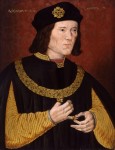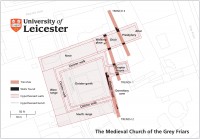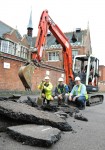 The original plan for the Leicester parking lot dig that was so astonishingly successful was to excavate two trenches over the course of two weeks which would be filled in and reverted to a parking lot at the end. That was based on everyone’s modest expectations of what they might find. Then the deities of archaeological good fortune laid giant sloppy kisses all over them so they were able to locate the Greyfriars church and abbey and, most importantly, human remains of a male with scoliosis, sharp force trauma to the skull and an arrowhead embedded in his back.
The original plan for the Leicester parking lot dig that was so astonishingly successful was to excavate two trenches over the course of two weeks which would be filled in and reverted to a parking lot at the end. That was based on everyone’s modest expectations of what they might find. Then the deities of archaeological good fortune laid giant sloppy kisses all over them so they were able to locate the Greyfriars church and abbey and, most importantly, human remains of a male with scoliosis, sharp force trauma to the skull and an arrowhead embedded in his back.
At the press conference where the discovery of the potential Richard III skeleton was announced, speakers noted that the plans for the dig site had obviously changed somewhat. Peter Soulsby, Mayor of Leicester, noted that the Leicester Council members were going to have to make do without their parking lots a while longer, as examination of the trenches would continue for the foreseeable future. At the same time, they made clear that the parking lot would return as soon as the archaeologists were through. When a reporter asked if there was any chance of the site remaining open for visitors, he was told that the archaeological site is not really “display quality” because there’s little to see other than the trenches themselves.
 Now it seems they’ve devised a compromise plan. Two of the three trenches will be entirely refilled and paved for parking lot purposes; however, the section of the trench where the skeleton was found will not be filled. (On the site map, it’s the bit that juts out from the Walking Place marked with a line. The dot at one end of the line is where the head was found.) It’s been covered by a protective tent to keep it safe from the elements. This is a temporary solution until they make a final decision on how best to preserve the grave site for future display, but it’s certain that the grave itself will be kept open.
Now it seems they’ve devised a compromise plan. Two of the three trenches will be entirely refilled and paved for parking lot purposes; however, the section of the trench where the skeleton was found will not be filled. (On the site map, it’s the bit that juts out from the Walking Place marked with a line. The dot at one end of the line is where the head was found.) It’s been covered by a protective tent to keep it safe from the elements. This is a temporary solution until they make a final decision on how best to preserve the grave site for future display, but it’s certain that the grave itself will be kept open.
As for the rest of the dig, the fragile parts of the trenches were first lined with a geotextile membrane (synthetic polymer sheets that are used in construction to separate substrate layers and keep them from intermixing but still allowing water to drain through normally), then backfilled with the same material that was removed during the initial excavation. This will preserve some of the more delicate church and abbey remains like the exposed mortar bedding from the tiled cloister floor even as it allows most of the dig site to be resurfaced and returned to parking lot duty.
 After six enormously successful open days over the second half of September when vistors flocked in thousands to see what is very likely to be the grave of the last king of England to die in battle, clearly the Leicester City Council realizes it would be madness to bury the goose that lays the golden eggs. If I had my druthers they’d kiss their parking lots goodbye and dig up the entire Greyfriars site, but that was never going to happen. They’d have to knock down buildings to expose all of the church and abbey, and they probably wouldn’t find anything underneath those buildings anyway because whatever ruins were there were probably destroyed during the later construction.
After six enormously successful open days over the second half of September when vistors flocked in thousands to see what is very likely to be the grave of the last king of England to die in battle, clearly the Leicester City Council realizes it would be madness to bury the goose that lays the golden eggs. If I had my druthers they’d kiss their parking lots goodbye and dig up the entire Greyfriars site, but that was never going to happen. They’d have to knock down buildings to expose all of the church and abbey, and they probably wouldn’t find anything underneath those buildings anyway because whatever ruins were there were probably destroyed during the later construction.
In fact, the skeleton itself came precipitously close to being irretrievably damaged by a Victorian building. Nineteenth century foundations begin less than a foot above where the skull of the probable king was found. Site director Mathew Morris said: “It was incredibly lucky. If the Victorians had dug down 30cm more they would have built on top of the remains and destroyed them.”
The DNA analysis is still ongoing. Results are expected before the end of the year. If DNA does confirm, the question of where the remains should be reinterred will explode. The Richard III Foundation has already started an online petition asking that Richard’s remains be buried in York Minster instead of the place where he was betrayed and defeated, corpse paraded naked through the streets and then unceremoniously buried as a usurper. The Leicester press has dismissed this effort because the organization is based in Virginia. Philippa Langley, secretary of the Scottish Branch of the Richard III Society, spent years working to make this dig happen and she is firmly on Leicester’s side, both for historical and practical reasons.
“When I started the process everybody said the remains should stay in Leicester. There’s a huge case for that because he’s been here for the past 527 years and it’s the Leicester authority which has paid for the dig and provided assistance from the start.”
She said York Minster waited 15 years before agreeing to house a stained-glass window dedicated to Richard. “It worries me to think the same will happen with the remains,” she said. “The problem is that York Minster is full and there might not be anywhere for him. I don’t want the body sitting around for more than decade [sic] before they decide where they’re going to put him.”
Ultimately the decision is going to rest with the Royal Household, and so far all signs suggest they’ll leave it in Leicester’s hands.
 On a lighter note, Emma Vieceli, the artist who along with Kate Brown and Paul Duffield created the five manga panels inspired by stained glass depicting Richard’s death, burial and excavation that were used as graphic backdrops during the press conference (you can see all five of them at the bottom of this entry), is working with her collaborators on a series of graphic novels about Richard III. They won’t be about the dig, just about the history of the king from his youth in Middleham to his death at Bosworth Field. She’s in talks with publishers now.
On a lighter note, Emma Vieceli, the artist who along with Kate Brown and Paul Duffield created the five manga panels inspired by stained glass depicting Richard’s death, burial and excavation that were used as graphic backdrops during the press conference (you can see all five of them at the bottom of this entry), is working with her collaborators on a series of graphic novels about Richard III. They won’t be about the dig, just about the history of the king from his youth in Middleham to his death at Bosworth Field. She’s in talks with publishers now.